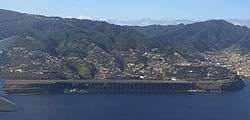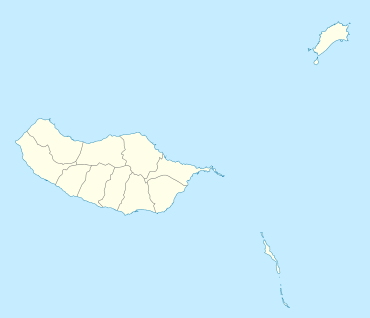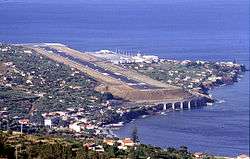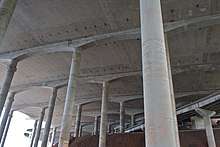Madeira Airport
Cristiano Ronaldo Madeira International Airport, commonly known as Madeira Airport (Portuguese: Aeroporto da Madeira) or Funchal Airport (Aeroporto do Funchal) (IATA: FNC, ICAO: LPMA), is an international airport in the civil parish of Santa Cruz in the Portuguese archipelago and autonomous region of Madeira. The airport is located 13.2 km (8.2 mi) east-northeast of the regional capital, Funchal, after which it is sometimes informally named. It mostly hosts flights to European metropolitan destinations due to Madeira's importance as a leisure destination, and is pivotal in the movement of cargo in and out of the archipelago of Madeira. It is the fourth-busiest airport in Portugal. The airport is named after Madeiran football player Cristiano Ronaldo.
Madeira International Airport Aeroporto da Madeira Cristiano Ronaldo | |||||||||||
|---|---|---|---|---|---|---|---|---|---|---|---|
 Approach to Madeira Airport, view of the supported half of the runway | |||||||||||
| Summary | |||||||||||
| Airport type | Public | ||||||||||
| Operator | ANA - Aeroportos e Navegação Aérea, SA | ||||||||||
| Serves | Madeira, Portugal | ||||||||||
| Location | Santa Cruz | ||||||||||
| Focus city for | TAP Air Portugal | ||||||||||
| Elevation AMSL | 58 m / 190 ft | ||||||||||
| Coordinates | 32°41′39″N 16°46′41″W | ||||||||||
| Website | ana.pt | ||||||||||
| Map | |||||||||||
 LPMA Location in Portugal | |||||||||||
| Runways | |||||||||||
| |||||||||||
| Statistics (2018) | |||||||||||
| |||||||||||
The airport is considered one of the most peculiarly perilous airports in the world[1] due to its location and its spectacular runway construction. It received the Outstanding Structure Award in 2004 by the International Association for Bridge and Structural Engineering.[2][3][4][5] The History Channel program Most Extreme Airports ranked it as the ninth most dangerous airport in the world and the third most dangerous in Europe.[6] Pilots must undergo additional training to land at the airport.[7]
Geography
Madeira Airport is an unusual airport geography-wise, as the airport is perched on a foreland jutting out to sea. At the end of runway 05, there lie hills and cliffs which make a direct ILS approach and landing unavailable. Instead aircraft have to do a visual approach which involves flying around the airport, then snaking around in a ~150° turn before lining up on a very short final approach. The airport's 05 end of the runway ends with a cliff with a motorway leading to the airport terminal below it. The runway 23 end of the runway is very interesting as it sits on a supported platform above ground as the ground below it is very far down. This time the approach path to runway 23 is more or less clear, meaning that ILS is available for approach.
History

Madeira Airport was officially opened on 7 July 1964, with two 1,600 m (5,200 ft; 1.6 km; 0.99 mi) runways. The first flight to land there was a TAP Air Portugal Lockheed Constellation with 80 passengers on board.[8]
In 1972, the popularity of visiting the island of Madeira increased, so the runway had to be extended to allow modern and larger aircraft to land. Considered the Kai Tak of Europe because of its singular approach to runway 05,[9] the decision was made to extend the existing runway instead of building a new one. The runway was extended to 1,800 m (5,900 ft; 1.8 km; 1.1 mi), with the extension inaugurated on 1 February 1986 by then president of the Portuguese Republic António Ramalho Eanes. In the meantime, a new terminal was built at the airport in 1973, handling 500,000 passengers.
However, as demand for tourism continued to grow, the runway had to be extended further. The newly extended runway—now 2,781 m (9,124 ft; 2.781 km; 1.728 mi) long—and terminal were inaugurated on 6 October 2002, and to mark the occasion, an Air Atlanta Icelandic Boeing 747-200, registration TF-ABA, landed at the airport.[10] Although this was a rare event, some TAP Air Portugal flights on the Lisbon-Caracas-Lisbon route used to have scheduled stops at Madeira with Airbus A330-200 widebody aircraft.
Name change
In 2016, it was announced that the airport would be renamed Madeira International Airport Cristiano Ronaldo (Aeroporto Internacional da Madeira Cristiano Ronaldo) in honour of Madeira native football player Cristiano Ronaldo.[11][12][13] The rebranded terminal was unveiled on 29 March 2017, with a bust of Ronaldo also being presented.[14]
Neither the bust nor the name change were unanimous, actually far from a consensus, as the former was ridiculed by Saturday Night Live's character Cecilia Giminez, portrayed by comedian and actress Kate McKinnon,[15] with the latter being subject to much debate and controversy locally by politicians and citizens, who even started a petition against the move.[16][17]
A year later, sports web site Bleacher Report commissioned sculptor Emanuel Santos to create another bust.[18] However, this bust was never used; instead a new one was made by a Spanish sculptor, shown to the public on 15 June 2018.[19]
Facilities

.jpg)


.jpg)
Runway
The airport was once infamous for its short runway, which, surrounded by high mountains and the ocean, made it a difficult and technically demanding landing for even the most experienced pilots. Because of the ~150° right-hand turn required, the airport has acquired the nickname of "Kai Tak Airport of Europe" - a reference to the former airport of Hong Kong that also needed a right-hand turn to line up for a landing very low and close to the runway. Between 1982 and 1986, Madeira's runway was extended by 200 m (656 ft) to a total of 1,800 m (5,906 ft), and four gates were opened. The original runway was only 1,600 m (5,249 ft) long, but was extended by 200 m (656 ft) eight years after the TAP Air Portugal Flight 425 crash of 1977.
In 2000, the runway was again extended, this time to 2,781 m (9,124 ft). As landfill was not a realistic option, the extension was built on a platform, partly over the ocean, supported by 180 columns, each about 70 m (230 ft) tall. The runway extension was conducted by the Brazilian construction company Andrade Gutierrez and is recognized worldwide as one of the most difficult to achieve due to the type of terrain and orography.
Its innovative solution allowed Funchal to receive the Outstanding Structure Award in 2004 by the International Association for Bridge and Structural Engineering,[2] which aims at recognizing the most remarkable, innovative, creative, or otherwise stimulating structure completed within the last few years.[3][4][5]
Terminal
The airport has a single terminal, which opened in 1973. The terminal has 40 check-in desks, 16 boarding gates, and 7 baggage belts. There are no air-bridges, so passengers either walk the short distance to the terminal or are taken by shuttle bus. The terminal itself is mostly underground.
Modernisation
In 2016, Madeira Airport was modernised and renovated by its operator, ANA Aeroportos de Portugal, as part of an €11 million investment. The renovated terminal area, which was opened in June 2016, by the President of the Autonomous Regional Government of Madeira, Miguel Albuquerque, improved the existing facility and facilitated the creation of a brand new shopping area, doubling the airport's overall capacity.
According to VINCI Airports, the airport will "have the capacity to deal with up to 1,400 passengers per hour", and the airport's overall new layout has been designed to enable to accommodation of new stores for national and international brands alike.[20]
The passenger screening area, under the command of Serviço de Estrangeiros e Fronteiras, increased from 7,000 sq ft (650m²) to 16,000 sq ft (1,500m²), accommodating an increase in the number of security screening lines, while the passenger holding and verification area increased from 300m² to 650m². The new layout has simplified the passenger experience, creating defined areas for the Schengen Area (which the Autonomous Region of Madeira is part of) and non–Schengen Area passengers, and given the airport operator the ability to alternate these areas based on flight schedules. A new transfer hall and three new departure gates were also created as part of the project.[21]
The renovation and investment project also accommodated the strengthening and re-profiling of the runway and taxiways, increasing the usable area by more than 16,000 sq ft (1,500 m²).
Airlines and destinations
Passenger
Statistics
| Rank | Country | City | Passengers | Carriers |
|---|---|---|---|---|
| 1 | Lisbon | 865,994 | EasyJet, TAP Air Portugal | |
| 2 | London | 227,096 | British Airways, EasyJet, Jet2.com, TUI Airways | |
| 3 | Porto | 218,992 | TAP Air Portugal, Transavia | |
| 4 | Manchester | 59,367 | EasyJet, Jet2.com, Thomas Cook Airlines, TUI Airways | |
| 5 | Porto Santo | 47,684 | Aero Vip | |
| 6 | Amsterdam | 44,270 | TUI Airlines Netherlands, Transavia | |
| 7 | Paris | 41,794 | Aigle Azur, Europe Airpost, SATA Internacional, Transavia France | |
| 8 | Helsinki | 39,284 | Finnair, Thomas Cook Scandinavia | |
| 9 | Bristol | 38,201 | EasyJet |
Accidents and incidents
- On 5 March 1973, an Aviaco Sud Caravelle 10R (registration EC-BID) crashed into the sea during the landing approach, losing the aircraft and three crew.[30]
- On 19 November 1977, TAP Air Portugal Flight 425, a Boeing 727-200 (registration CS-TBR), was traveling from Brussels to Madeira via Lisbon. After a go-around, the aircraft attempted to land in poor weather conditions. It landed long on runway 24 (now runway 23) and plunged over a steep bank. It then struck a stone bridge, and the right wing was torn off, and then it crashed hard onto a beach. A fire broke out, setting the aircraft alight. Out of the 164 on board, 131 lost their lives.[31]
- On 18 December 1977, SA de Transport Aérien Flight 730, a Sud Caravelle 10R (registration HB-ICK), was cleared for approach on runway 06 (now runway 05), but descended below 720 ft (220 m), causing the aircraft to crash into the sea. 36 people died of the 57 on board.[32]
References
- "The world's scariest airport landings: videos". The Telegraph. Telegraph Media Group Limited. 18 June 2016.
- "Funchal Airport Extension, Madeira Island, Portugal". Iabse.org. Archived from the original on 28 May 2014.
- Advanced Solutions International, Inc. "OStrA". Iabse.org. Archived from the original on 25 August 2017. Retrieved 25 August 2017.
- "The Outstanding Structure Award". Iabse.ethz.ch. Archived from the original on 27 February 2012.
- "Outstanding Structure Award". Ordemengenheiros.pt.
- The Most Extreme Airports (video). The History Channel. 26 August 2010.
- "Madeira Special Approach Familiarization (Traditional Classroom & Simulator) - FlightSafety International". elearning.flightsafety.com. Retrieved 15 June 2018.
- Madeira Airport's history, by RTP Madeira, in Portuguese, (video), 07.04.2020
- "Welcome listphobia.com - BlueHost.com". listphobia.com. Retrieved 25 August 2017.
- "Old Memories – 747 in Madeira – Rui Sousa, Looking through the glass". Photoblog.com.
- "Madeira airport to be named after Cristiano Ronaldo". FourFourTwo. FourFourTwo. Archived from the original on 2 February 2017. Retrieved 23 July 2016.
- "Madeira airport renamed after Cristiano Ronaldo". The World Game. Special Broadcasting Service. Retrieved 23 July 2016.
- "Nome do Aeroporto Cristiano Ronaldo cria mal-estar entre governos do Funchal e Lisboa". Publico.pt. Retrieved 25 August 2017.
- Berenguer, Márcio. "Nome do Aeroporto Cristiano Ronaldo cria mal-estar entre governos do Funchal e Lisboa". Publico.pt. Retrieved 25 August 2017.
- Saturday Night Live (9 April 2017). "Weekend Update: Cecilia Gimenez on Cristiano Ronaldo Bust - SNL". Retrieved 15 June 2018 – via YouTube.
- "Madeira airport preparing to be renamed after Cristiano Ronaldo". Retrieved 15 June 2018.
- "Cristiano Ronaldo airport rename critics slammed by Madeira president". Retrieved 15 June 2018.
- "Ronaldo statue: Sculptor Emanuel Santos takes another shot at bust". BBC News. 30 March 2018. Retrieved 30 May 2018.
- "Aeroporto da Madeira tem novo busto de Cristiano Ronaldo". Diário de Notícias Madeira. 17 June 2018. Retrieved 17 June 2018.
- "VINCI Airports - Madeira Airport invests €11 million in its new shopping galleria". Vinci-airports.com. Retrieved 25 August 2017.
- "Madeira International Airport Modernisation, Madeira Island - Airport Technology". 17 June 2016. Archived from the original on 17 June 2016. Retrieved 15 June 2018.
- "Voos regulares e charters para a ilha da Madeira". www.visitmadeira.pt. Retrieved 15 June 2018.
- "Bilety czarterowe – tanie bilety lotnicze | Biuro podróży TUI".
- Liu, Jim. "Iberia adds Barcelona – Funchal seasonal service in S20". Routesonline. Retrieved 3 January 2020.
- "Find a Flight | oneworld". www.oneworld.com.
- 2017, UBM (UK) Ltd. "Jet2 plans Birmingham – Funchal Oct 2017 launch". Routesonline.com. Retrieved 25 August 2017.CS1 maint: numeric names: authors list (link)
- Solférias Madeira schedules charter flights to Sal from Madeira on Summer, Presstur.com, in Portuguese, 07.02.2020
- Swiftair with daily flights to Madeira from this week, Jornal Económico, Madeira Edition, in Portuguese, 04.03.2020
- EC-BID at the Aviation Safety Network
- CS-TBR at the Aviation Safety Network
- HB-ICK at the Aviation Safety Network
External links
![]()